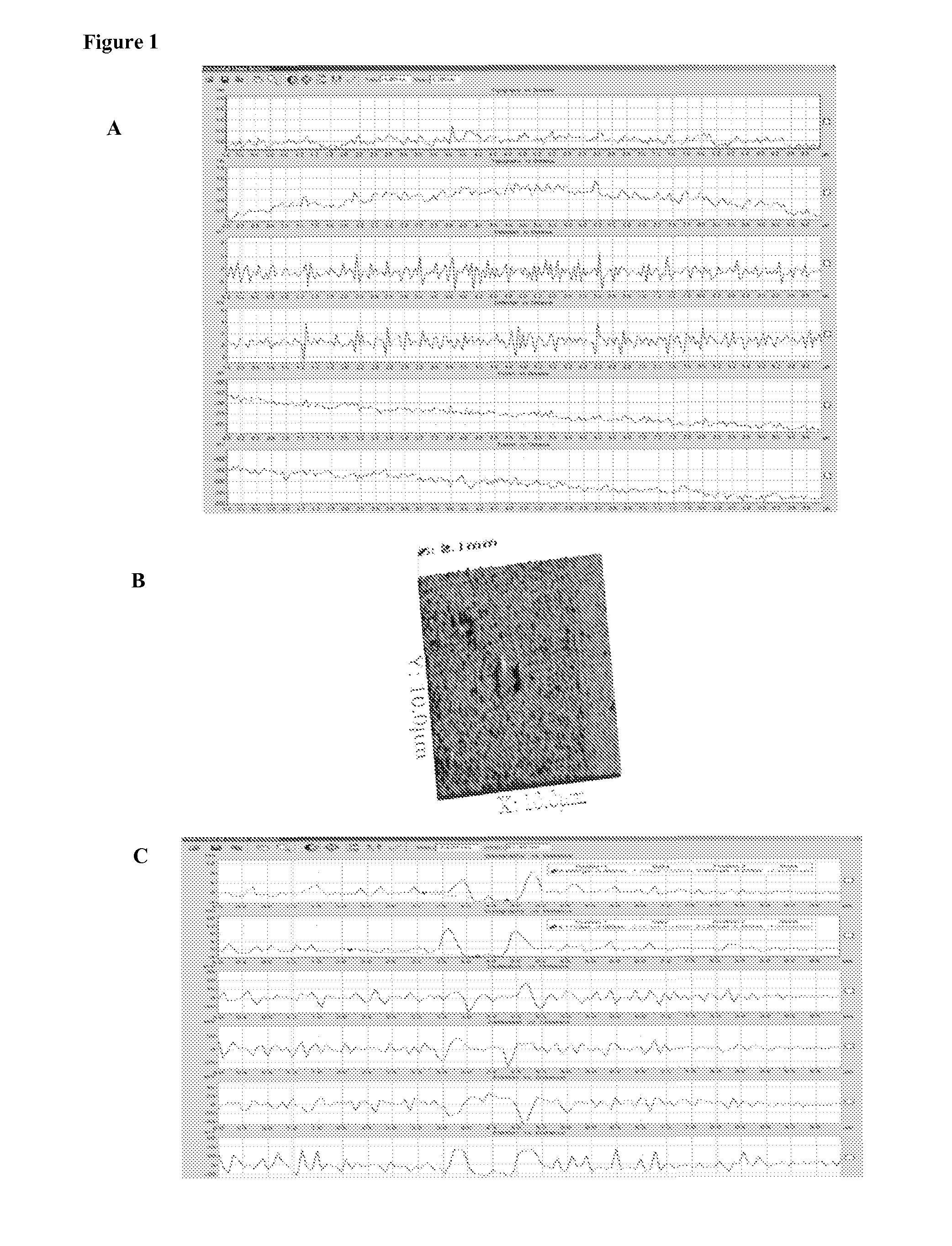Biocoated piezoelectric biosensor platform for point-of-care diagnostic use
a biosensor and biosensor technology, applied in the field of biosensor platforms for point-of-care diagnostic use, can solve the problems of low sensitivity, high variability, and current state of art poc devices, and achieve the effects of simple manufacturing process, rapid poc diagnosis, and cost-effectiveness
- Summary
- Abstract
- Description
- Claims
- Application Information
AI Technical Summary
Benefits of technology
Problems solved by technology
Method used
Image
Examples
example 1
Manual Processes for Coating of Biosensor Chips Bearing Neutravidin and Biotinylated Antibody
[0095]All of these methods have been actually performed.
[0096]a. Coating without fixation: Clean and activate LiNbO3 surfaces for about 1-10 sec at atmospheric pressure with a plasma generating device (e.g. Plasma Treat USA, Elgin, Ill.) before application of avidin which is accomplished by inkjetting avidin in a solution containing 50% glycerol in PBS at an avidin concentration of 0.5 mg / ml, followed with brief drying using warm air from a heat gun at about 50° C. or drying at room temperature for about 30 min to bond the avidin to the surface, the biosensor is now ready for use or packaging.
[0097]Optionally, deposition of neutravidin is followed by a fixing step.
[0098]b. Coating with thermal fixation: Neutravidin is applied by ink jetting as described in Example 1a. The neutravidin may be fixed to the piezo substrate by heating to about 30-50° C. with an infrared heat lamp for up to 30 min...
example 2
Automated Coating Processes
[0102]a. Automated Direct Coating Mode for Neutravidin Biosensors:
[0103]Online manufacturing of some embodiments involves deposition of neutravidin coating on piezo crystals affixed to the lower portion of the biosensor housing that is then mounted on a conveyor belt. After plasma treatment, the sensor is moved to the neutravidin inkjetting station and coated with 5-10 μl of fluid containing 0.01 to 5.0 mg / ml neutravidin; or 0.01-2.0 mg / ml; or 0.01-1.0 mg / ml by weight per 0.5 cm square area. The fluid is evaporated and the neutravidin fixed on the biosensor by brief exposure to heat from a heat gun (about 50° C.). The upper cover of the housing is then affixed to form the leak proof fluid chamber of the biosensor cartridge.
[0104]b. Automated Coating Mode for Coated Neutravidin Having Biotinylated Antibody:
[0105]A similar inkjet process as described above in 2a is used to coat the biotinylated antibody diluted to a suitable dilution in a non-drying stabiliz...
example 3
Chlamydia trachomatis Detected on the Biosensor
[0110]Experiments were conducted with C. trachomatis, an obligate intracellular bacterium which causes a sexually transmitted disease in both women and men. The procedures used to coat avidin and antibody are described in Example 1. The antibody used is a monoclonal antibody against the major outer membrane (MOMP) of C. trachomatis (Abcam) biotinylated and used at 0.25 μg / ml. C. trachomatis was obtained from Microbia and was suspended in PBS / Buffer at a concentration of 105 per ml in a similar experiment, monoclonal antibody directed against C. trachomatis elementary body lipopolysaccharide (Medix). A aliquot of elementary bodies (EB) of 105 EB+0.25 μg / ml of biotinylated anti-EB LPS was incubated for 30 minutes at RT and then added to the chip. FIGS. 6 and 7 depict the results of experiments conducted with these specific infectious antigens. FIG. 6 is a series of black and white tracings of a fluorescent microscopy slide taken of an AMT...
PUM
| Property | Measurement | Unit |
|---|---|---|
| Time | aaaaa | aaaaa |
| Thickness | aaaaa | aaaaa |
| Phase | aaaaa | aaaaa |
Abstract
Description
Claims
Application Information
 Login to View More
Login to View More - R&D
- Intellectual Property
- Life Sciences
- Materials
- Tech Scout
- Unparalleled Data Quality
- Higher Quality Content
- 60% Fewer Hallucinations
Browse by: Latest US Patents, China's latest patents, Technical Efficacy Thesaurus, Application Domain, Technology Topic, Popular Technical Reports.
© 2025 PatSnap. All rights reserved.Legal|Privacy policy|Modern Slavery Act Transparency Statement|Sitemap|About US| Contact US: help@patsnap.com



